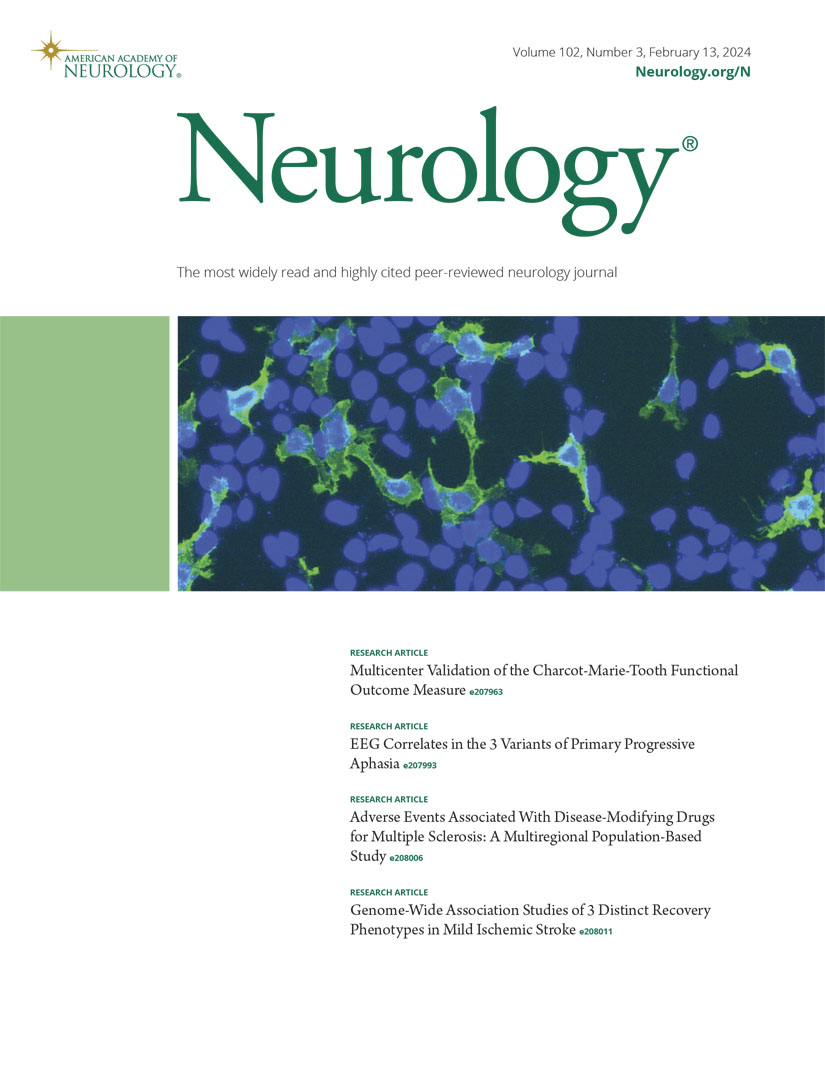Multiple Sclerosis-Specific Reference Curves for Brain Volumes to Explain Disease Severity.
IF 7.7
1区 医学
Q1 CLINICAL NEUROLOGY
引用次数: 0
Abstract
BACKGROUND AND OBJECTIVES Brain atrophy is relevant for understanding disease progression and treatment response in people with multiple sclerosis (pwMS). Automatic brain volume-reporting tools often rely on healthy control (HC) reference curves to interpret brain volumes, whereas brain volume loss is different in pwMS. This observational study aimed to develop an MS-specific reference model for brain volumes and evaluate its performance compared with HC-based curves, as a proof-of-concept. METHODS Participants, pwMS and HCs, from the Amsterdam MS cohort were included based on the availability of T1-weighted MR scans. Normalized brain volumes (NBVs) were obtained using commercially available software. The software program also provides NBV percentiles, based on age-specific and sex-specific HC curves, grouped into NBV quartiles, describing deviation from expected NBVs. Disease severity was determined with the MS severity score (MSSS), Symbol Digit Modalities Test (SDMT), and 9-Hole Peg Test (9HPT). An MS-specific model was developed by regressing NBVs against age, sex, disease duration, and MS phenotype. The resulting MS model was also used to classify pwMS into quartiles describing deviation from expected NBV, given the modeled patient characteristics, with leave-one-out predictions. Quartile classification from HC-based and MS-based reference curves was compared with MSSS using analysis of variance (ANOVA). RESULTS Regressions for NBVs from 713 pwMS and 259 HCs (mean age: 49.1 ± 9.7 and 48.3 ± 10.1, %female: 70.4% and 67.2%, respectively) were significant for age, sex, disease duration, and phenotype, which were included in the MS-specific model. MS-specific model quartile designations significantly improved associations with MSSS values (p = 2.2*10-9, η2 = 0.06) compared with HC-based quartiles. MSSS values worsened with lower NBV quartiles in the MS-specific model (difference between quartiles 1-4 = -0.84, p = 6.1*10-3, 95% CI [-1.5 to -0.18])), which was not observed for HC-based quartiles (p = 0.98). Quartile group differences were observed for 9HPT (MS: p = 3.5*10-3, η2 = 0.02, HC: p = 6.6*10-3, η2 = 0.02) and SDMT (MS: p = 3.1*10-4, η2 = 0.05, HC: p = 5.4*10-4, η2 = 0.04) values, but MS-specific quartiles again improved quartile associations (p = 0.036, η2 = 0.01 and p = 0.02, η2 = 0.01, respectively). DISCUSSION NBV values derived from an MS-specific reference model offer improved relevance for assessing disease severity compared with curves derived from age-specific and sex-specific HC reference models. Improving the model toward application in individual people could enhance clinical implementation.多发性硬化症脑容量特异性参考曲线解释疾病严重程度。
背景与目的脑萎缩与了解多发性硬化症(pwMS)患者的疾病进展和治疗反应有关。自动脑容量报告工具通常依赖于健康对照(HC)参考曲线来解释脑容量,而脑容量损失在pwMS中是不同的。这项观察性研究旨在开发ms特异性脑容量参考模型,并将其与基于hc的曲线进行比较,以评估其性能,作为概念验证。方法根据t1加权MR扫描的可用性纳入来自阿姆斯特丹MS队列的参与者,pwMS和hc。规范化脑容量(NBVs)使用市售软件获得。该软件程序还提供NBV百分位数,基于特定年龄和性别的HC曲线,分组成NBV四分位数,描述与预期NBV的偏差。采用MS严重程度评分(MSSS)、符号数字模式测试(SDMT)和9孔Peg测试(9HPT)来确定疾病严重程度。通过回归NBVs对年龄、性别、病程和MS表型的影响,建立了MS特异性模型。由此产生的MS模型也被用于将pwMS分为四分位数,描述与预期NBV的偏差,考虑到建模的患者特征,并进行留一预测。采用方差分析(ANOVA)比较基于hc和ms的参考曲线的四分位数分类。结果713例pwMS和259例HCs(平均年龄:49.1±9.7和48.3±10.1,%女性:分别为70.4%和67.2%)的NBVs在年龄、性别、病程和表型上的回归均具有显著性,这些数据被纳入ms特异性模型。与基于hc的四分位数相比,ms特异性模型四分位数名称显著改善了与MSSS值的关联(p = 2.2*10-9, η2 = 0.06)。在ms特异性模型中,随着NBV四分位数的降低,MSSS值恶化(四分位数1-4之间的差异= -0.84,p = 6.1*10-3, 95% CI[-1.5至-0.18]),而基于hc的四分位数未观察到这种情况(p = 0.98)。9HPT (MS: p = 3.5*10-3, η2 = 0.02, HC: p = 6.6*10-3, η2 = 0.02)和SDMT (MS: p = 3.1*10-4, η2 = 0.05, HC: p = 5.4*10-4, η2 = 0.04)值的四分位数组间存在差异,但MS特异性四分位数再次改善了四分位数相关性(p = 0.036, η2 = 0.01和p = 0.02, η2 = 0.01)。与年龄特异性和性别特异性HC参考模型得出的曲线相比,ms特异性参考模型得出的nbv值在评估疾病严重程度方面具有更高的相关性。改进模型,面向个体应用,可提高临床执行力。
本文章由计算机程序翻译,如有差异,请以英文原文为准。
求助全文
约1分钟内获得全文
求助全文
来源期刊

Neurology
医学-临床神经学
CiteScore
12.20
自引率
4.00%
发文量
1973
审稿时长
2-3 weeks
期刊介绍:
Neurology, the official journal of the American Academy of Neurology, aspires to be the premier peer-reviewed journal for clinical neurology research. Its mission is to publish exceptional peer-reviewed original research articles, editorials, and reviews to improve patient care, education, clinical research, and professionalism in neurology.
As the leading clinical neurology journal worldwide, Neurology targets physicians specializing in nervous system diseases and conditions. It aims to advance the field by presenting new basic and clinical research that influences neurological practice. The journal is a leading source of cutting-edge, peer-reviewed information for the neurology community worldwide. Editorial content includes Research, Clinical/Scientific Notes, Views, Historical Neurology, NeuroImages, Humanities, Letters, and position papers from the American Academy of Neurology. The online version is considered the definitive version, encompassing all available content.
Neurology is indexed in prestigious databases such as MEDLINE/PubMed, Embase, Scopus, Biological Abstracts®, PsycINFO®, Current Contents®, Web of Science®, CrossRef, and Google Scholar.
 求助内容:
求助内容: 应助结果提醒方式:
应助结果提醒方式:


